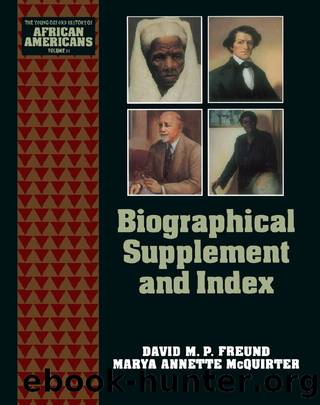Biographical Supplement and Index by Freund David M. P.;McQuirter Marya Annette;Freund David M. P.;McQuirter Marya Annette;

Author:Freund, David M. P.;McQuirter, Marya Annette;Freund, David M. P.;McQuirter, Marya Annette;
Language: eng
Format: epub
Publisher: Oxford University Press, Incorporated
Published: 2014-08-15T00:00:00+00:00
Parker, Charlie
(âYardbird,â âBirdâ)
SAXOPHONIST, COMPOSER
Born: August 29, 1920
Kansas City, Kansas
Died: March 12, 1955
New York, New York
Charlie Parkerâs work as a jazz composer and soloist revolutionized American music during the 1940s and 1950s. As a child, Parker was steeped in jazz and the blues. When he was seven years old, his family moved to Kansas City, Missouri, which was at the time an important center of African-American music. After taking lessons on the baritone sax in the public schools Parker taught himself the alto sax at the age of 10 and began to play in local groups. Soon after hearing alto sax great Lester Young play at a local club in 1934, Parker left high school to become a full-time musician. He played Kansas City clubs throughout the late 1930s and in 1939 visited New York City, where he was deeply influenced by artists such as Buster âProf Smith and Art Tatum.
Later that year he moved to New York City, where he remained based for most of his professional career. During the early 1940s he performed with big bands led by Jay McShann, Earl Hines, and Billy Eckstine, and participated in small-group, after-hours jam sessions at clubs, including Mintonâs Playhouse and Monroeâs Uptown House. It was in these small-group settings that Parker felt free to explore new approaches to composition and improvisation. Together with innovators such as Dizzy Gillespie, Kenny Clarke, Bud Powell, Thelonious Monk, and Max Roach, Parker helped develop and popularize a style of jazz known as âbebopâ (or âbopâ). Parker introduced approaches to melody, harmony, and, most fundamentally, to rhythm that changed the ways that many musicians played jazz.
By 1945, Parker was leading his own small group in New York and was working with Dizzy Gillespie on a regular basis. In 1947 Parker formed perhaps his most famous quintet, which included Tommy Potter, Miles Davis, Duke Jordan, and Max Roach. Parker also played with a number of other small groups, with string bands, and with Afro-Cuban groups during the late 1940s. He toured Europe in 1949 and 1950.
Parker was plagued by drug and alcohol addiction throughout his career. Suffering from poor health and deeply in debt, Parker committed himself to Bellevue Hospital in New York in 1954. He performed briefly after his release, but died in 1955 at the age of 34.
He left behind a remarkable legacy. Many of Parkerâs contemporaries rejected bebop, feeling that it was too radical a departure from musicâs mainstream. But many others embraced his work, and by the mid-1950s countless artists were playing bop and were further exploring its innovations. Parkerâs recordings, made between 1940 and 1955, are regarded today as legendary and are seen as documents of a period of experimentation central to the history of modern jazz. Parkerâs work continues to influence the ways that musicians compose and perform the music.
FURTHER READING
Frankl, Ron. Charlie Parker. New York: Chelsea House, 1993.
Giddins, Gary. Celebrating Bird: The Life of Charlie Parker. Morrow, 1986.
Russell, Ross. Bird Lives: The High Life and Hard Times of Charlie (Yardbird) Parker.
Download
This site does not store any files on its server. We only index and link to content provided by other sites. Please contact the content providers to delete copyright contents if any and email us, we'll remove relevant links or contents immediately.
| Africa | Ancient |
| Asia | Biographical |
| Canada | Europe |
| Exploration & Discovery | Holocaust |
| Medieval | Middle East |
| Military | Prehistory |
| Renaissance | United States |
Invictus by Ryan Graudin(5007)
The Gentleman's Guide to Vice and Virtue by Mackenzi Lee(4681)
Call me by your name by Andre Aciman(4496)
Pocahontas by Joseph Bruchac(4071)
The Book Thief by Markus Zusak(3915)
Lies We Tell Ourselves by Robin Talley(2997)
The Wrath and the Dawn by Ahdieh Renee(2659)
Less by Andrew Sean Greer(2595)
The Rose and the Dagger (The Wrath and the Dawn) by Renée Ahdieh(2532)
Hunting Prince Dracula (Stalking Jack the Ripper Book 2) by Kerri Maniscalco(2278)
Lair of Dreams (The Diviners #2) by Libba Bray(2217)
Stalking Jack the Ripper by Kerri Maniscalco(2197)
Call Me by Your Name: A Novel by André Aciman(2139)
Chronicles of Ancient Darkness by Michelle Paver(2051)
Lair of Dreams by Bray Libba(2010)
Practical Magic by Alice Hoffman(2007)
Clockwork Angel - Cassandra Clare by Cassandra Clare(1832)
Girl in the Blue Coat by Monica Hesse(1743)
The Glittering Court by Richelle Mead(1731)
